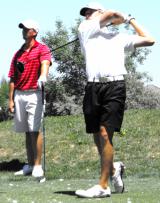Warm weather last fall helped ease the short-term pain somewhat for public golf course operators in Colorado, but the long-term trends can’t help but leave them cold.
The CGA recently completed its public course rounds and revenue survey for 2010, and it looks better than the previously released results for the first two-thirds of the year. But despite improvement late in 2010, making ends meet remained very challenging.
Almost 60 courses responded to the survey, and about two-thirds reported that their number of rounds played was down compared to 2009. The average decline was about 2.3 percent among all the facilities that provided figures for each of the last two years.
The better news for course operators was that green fee revenue per 18-hole round increased by an average of about 60 cents.
Generally speaking, “It’s more of the same,” CGA executive director Ed Mate said. “We’re treading water. It could be worse, I guess.”
If you’re looking for a silver lining for an industry that hasn’t gotten much good news recently, it’s that the full-year figures appear noticeably better than the ones for the first eight months of 2010. Through August, rounds were down 11.7 percent and green fee revenue sank 10.2 percent compared to the same period in 2009.
“There’s no explanation other than the weather,” said Mate, who has some first-hand knowledge of the situation as the CGA and CWGA own and operate CommonGround Golf Course in Aurora. “Thank goodness we had a good fall. It made the year not as bad as expected.”
Though Mate doesn’t foresee that 2011 will be appreciably better than 2010 — unless there are many more golf days allowed by the weather — others take a slightly more optimistic view.
Kevin Laura, president of Green Valley Ranch Golf Club in northeast Denver, said there was an uptick in business last year and he expects that to continue in 2011.
“2008 was the last good year we had, and I think we’ll be getting back to those ’08 levels,” Laura said. “I believe 2011 will be the year that we’ll complete the bounce-back.”
But the longer-term trends remain problematic for course operators. Even over the course of the last five years, rounds have dipped significantly — an average of 11.6 percent for Colorado public facilities, according to the CGA survey. And the numbers are even worse if you compare back even further.
Mate has sampled a handful of courses that have participated in the CGA rounds and revenue survey over the last 18 years, and a 25 percent decrease in annual rounds is typical among those facilities over that period.
“There’s been little or no increase in golfers, so the main reason we’re down is that there are many more courses in the mix,” Mate said. “The slices of the pizza are getting smaller.”
Indeed, while the National Golf Foundation reports that the number of golfers in the U.S. declined slightly from 1990 to 2009, more than 100 new courses have opened in Colorado during that period, according to CGA records.
The net effect, in Mate’s opinion, is that “golf courses are getting a little deeper into a hole each year” and have little money for needed capital improvements. “In the best-case scenario, a lot of courses are hanging on by their fingernails,” Mate said. “In the worst case, we’ll see (more) courses close.”
While Mate doesn’t foresee the overall outlook changing much in the short term for Colorado courses, he’s more hopeful over the longer haul thanks in part to initiatives such as the recently-launched Colorado PGA Golf in Schools Program, presented by the Colorado Open Golf Foundation and co-sponsored by the CGA and CWGA.
“Ten years from now, you may see an effect due to the Golf in Schools Program and other player development programs,” Mate said.


